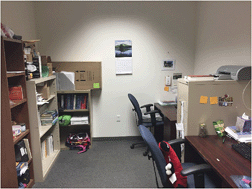Total surface area in indoor environments†
Abstract
Certain processes in indoor air, such as deposition, partitioning, and heterogeneous reactions, involve interactions with surfaces. We have characterized the surface area, volume, shape, and material of objects in 10 bedrooms, nine kitchens, and three offices. The resolution of the measurements was ∼1 cm. The ratio of surface area with contents to that without contents did not vary by type of room and averaged 1.5 ± 0.3 (mean ± standard deviation) across all rooms. The ratio of the volume minus contents to nominal volume averaged 0.9 ± 0.1 and was lower for kitchens compared to bedrooms and offices. Ignoring contents, the surface-area-to-volume ratio was 1.8 ± 0.3 m−1; accounting for contents, the ratio was 3.2 ± 1.2 m−1, or 78% higher. These two ratios did not vary by type of room and were similar to those measured for 33 rooms in another study. Due to substantial differences in the design and contents of kitchens, their ratios had the highest variability among the three room types. The most common shape of surfaces was flat rectangular, while each room also had many irregularly-shaped objects. Paint-covered surfaces and stained wood were the two most common materials in each room, accounting for an average of 42% and 22% of total surface area, respectively, although the distribution of materials varied by room type. These findings have important implications for understanding the chemistry of indoor environments, as the available surface area for deposition, partitioning, and reactions is higher and more complex than assumed in simple models.

- This article is part of the themed collection: Indoor Air: Sources, Chemistry and Health Effects


 Please wait while we load your content...
Please wait while we load your content...
